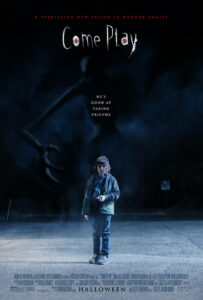Film Review: Intriguing Setup of “Come Play” Quickly Falters
Written by: Christopher Llewellyn Reed | October 30th, 2020

Come Play (Jacob Chase, 2020) 1½ out of 4 stars.
Though I am neither autistic nor a parent to an autistic child, I suspect that some might find the new horror film Come Play, from director Jacob Chase (The Four-Faced Liar), a somewhat problematic – or at least superficial – portrait of a kid on the spectrum. Beyond that particular issue, the movie has its share of additional narrative struggles, though its initial premise fascinates. For the monster that lurks just out of sight, waiting to pounce, spies on us from within our cherished electronic devices, using them as windows from his world to ours. His name is Larry (based on an earlier short film by Chase), and he is lonely. Will you be his friend? Just grab his outstretched hand.
On second thought, don’t. For it may be the last thing you do as a regular, live human being. Such is the intriguing setup for Come Play, married to the story of how Oliver (Azhy Robertson, Marriage Story), a young boy with autism, struggles to get by both at home and in school. Non-verbal, he communicates via his smartphone, which allows him to select words that speak for him. Not surprisingly, given the nature of people, he is a target of bullies, and therefore a perfect mark for the lurking Larry.

The film wastes no time introducing the monster; in fact, it’s a little too rushed in its push to establish the creepy menace, for we have no chance to understand character dynamics before we’re in the middle of the nightmare. In the opener, Oliver is watching a SpongeBob SquarePants video on his iPad when we cut to a POV from inside it, and then his screen is taken over by an illustrated tale entitled “Misunderstood Monsters.” As he starts to read (about Larry), little by little the lights in his room go off, and he begins to hear creaking sounds and dragging footsteps. Larry, it seems, might be on his way. But then, just when the door rattle, forcing Oliver deeper under his bedsheets, his mom bursts in, instead. Close call!
Mom (Gillian Jacobs, I Used to Go Here) and Dad (John Gallagher Jr., 10 Cloverfield Lane), though both loving parents, have challenges of their own, most notably that they don’t seem to get along all that well, prompting him to move out. Given the arrival of Larry in their lives, it’s not the best moment for that, but it does allow for some occasionally nice plot twists. Unfortunately, neither is particularly well sketched, and so their misery as a couple fails to resonate.

What works in Come Play is the creature design, both in terms of sound and look, as well as the clever notion of how he can be seen (only through a smart device), even if some of his look, as well as his interdimensionality, seems derived from Netflix’s Stranger Things. He still appeals in an appropriately eerie way. Given the paper thin development of those he terrifies, he has the biggest personality of all. This viewer was rooting for him to find that friend he needs.
What doesn’t work is everything else, from the way autism is used as a plot device, to the dialogue between parents and children and the silly decisions everyone makes along the way. Despite the legitimately terrifying notion of what it would be like to lose a child, Come Play fails to offer genuine scares. It holds interest for a while, which is no small thing, but ultimately we tire, and look for a new game. Sorry, Larry.


